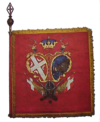Milenko Stojković
- View a machine-translated version of the Serbian article.
- Machine translation, like DeepL or Google Translate, is a useful starting point for translations, but translators must revise errors as necessary and confirm that the translation is accurate, rather than simply copy-pasting machine-translated text into the English Wikipedia.
- Do not translate text that appears unreliable or low-quality. If possible, verify the text with references provided in the foreign-language article.
- You must provide copyright attribution in the edit summary accompanying your translation by providing an interlanguage link to the source of your translation. A model attribution edit summary is
Content in this edit is translated from the existing Serbian Wikipedia article at [[:sr:Миленко Стојковић]]; see its history for attribution. - You may also add the template
{{Translated|sr|Миленко Стојковић}}to the talk page. - For more guidance, see Wikipedia:Translation.
 Milenko Stojković | |
| Native name | Миленко Стојковић |
|---|---|
| Birth name | Milenko Stojković |
| Born | 1769 (1769) Dobrnje, Sanjak of Smederevo, Ottoman Empire |
| Died | 1831 (1832) |
| Allegiance |  Revolutionary Serbia Revolutionary Serbia |
| Rank | Bimbaša Voivode |
| Battles/wars | Battle of Ivankovac |
Milenko Stojković (Serbian Cyrillic: Миленко Стојковић; 1769, Kličevac, Požarevac – 1831, Bakhchysarai, Crimea) was a Serbian revolutionary and bimbaša in the First Serbian Uprising early in the 19th century. He is most famous for executing four dahije (renegade janissaries) tyrants during the start of the First Serbian Uprising, in vengeance for the "Slaughter of the Knezes".
Having apprehended and, while running away, Milenko executed the Turkish tyrants Aganlija, Kučuk Alija, Mula Jusuf, and Mehmed Fočić, responsible for the killing of Serbian Princes that triggered the First Serbian Uprising, on the island of Ada Kaleh on the River Danube.[1] He was also known for keeping a harem of Muslim women who were widows of slain Ottoman Turks.[2]
He distinguished himself in the Battle of Ivankovac, and Battle of Malajnica and Štubik.[3]
In 1810, Stojković and Petar Dobrnjac led a failed revolt against uprising leader Karađorđe, leading them to be banished from Serbia a year later.[4]
He died in Russia.[3]
See also
References
- ^ Trajković, Lj̀ubica D.; Balašević, Jovan; Ćukić, Dragan (1968). Srbija: Itinereski vodič. Turistički savez Srbije. p. 118.
- ^ Hoare, Marko Attila (2024). Serbia: A Modern History. Oxford University Press. p. 50. ISBN 9780197769423.
- ^ a b Bataković, Dušan (2005). Histoire du peuple serbe (in French). L'age d'homme. p. 138. ISBN 9782825119587.
- ^ Cirkovic, Sima M. (2008). The Serbs. John Wiley & Sons. pp. 180–181. ISBN 9781405142915.
Further reading
- Simić, Tomislav M. (2003). Gospodar Milenko Stojković. Istorijski arhiv. ISBN 978-86-82395-13-3.
- v
- t
- e
- Đorđe Petrović-Karađorđe
- Uzun-Mirko Apostolović
- Ilija Barjaktarović
- Anta Bogićević
- Mina Bimbaša
- Đura Brničanin
- Pavle Cukić
- Vasa Čarapić
- Ilija Čarapić
- Stojan Čupić
- Sava Dedobarac
- Aćim Doljanac
- Dimitrije Đorđević
- Todor-Toša Đorđević
- Stanoje Glavaš
- Jovan Gligorijević-Zeka Buljubaša
- Hadži-Prodan Gligorijević
- Nikola Grbović
- Petar Ičko
- Jovan Jančić-Sarajlija
- Jakov Jakšić
- Stojan Karadžić
- Janko Katić
- Ivan-Ivo Knežević
- Vreta Kolarac
- Cincar-Marko Kostić
- Naum Krnar
- Marko Krstić
- Dimitrije Kujundžić
- Jovan Kursula
- Milosav Lapovac
- Luka Lazarević
- Raka Levajac
- Arsenije Loma
- Paulj Matejić
- Sima Marković
- Tomo Milinović
- Mladen Milovanović
- Mateja Nenadović
- Sima Nenadović
- Jakov Nenadović
- Petar Nikolajević-Moler
- Dositej Novaković
- Petar Novaković-Čardaklija
- Đorđe Obradović-Ćurčija
- Jovan Obrenović
- Miloš Obrenović
- Dragan Papazoglu
- Dimitrije Parezan
- Pavle Popović
- Milutin-Era Petrović
- Ilija Strelja
- Hajduk-Veljko Petrović
- Radič Petrović
- Cincar-Janko Popović
- Mihailo Radović
- Tanasko Rajić
- Old Rashko
- Antonije Ristić-Pljakić
- Milutin Savić-Garašanin
- Čolak-Anta Simeonović
- Jovan Simić Bobovac
- Stevan Sinđelić
- Nikola Smiljanić
- Miloš Stojićević Pocerac
- Milenko Stojković
- Đorđe Šagić
- Petar Teodorović-Dobrnjac
- Miloje Todorović
- Milosav Zdravković-Resavac
- Vuča Žikić
- Nikola Ziković
- Kara-Marko Vasić
- Konda Bimbaša
- Toma Vučić Perišić
- Vujica Vulićević


 | This biographical article related to the European military is a stub. You can help Wikipedia by expanding it. |
- v
- t
- e
  | This Serbian biographical article is a stub. You can help Wikipedia by expanding it. |
- v
- t
- e













